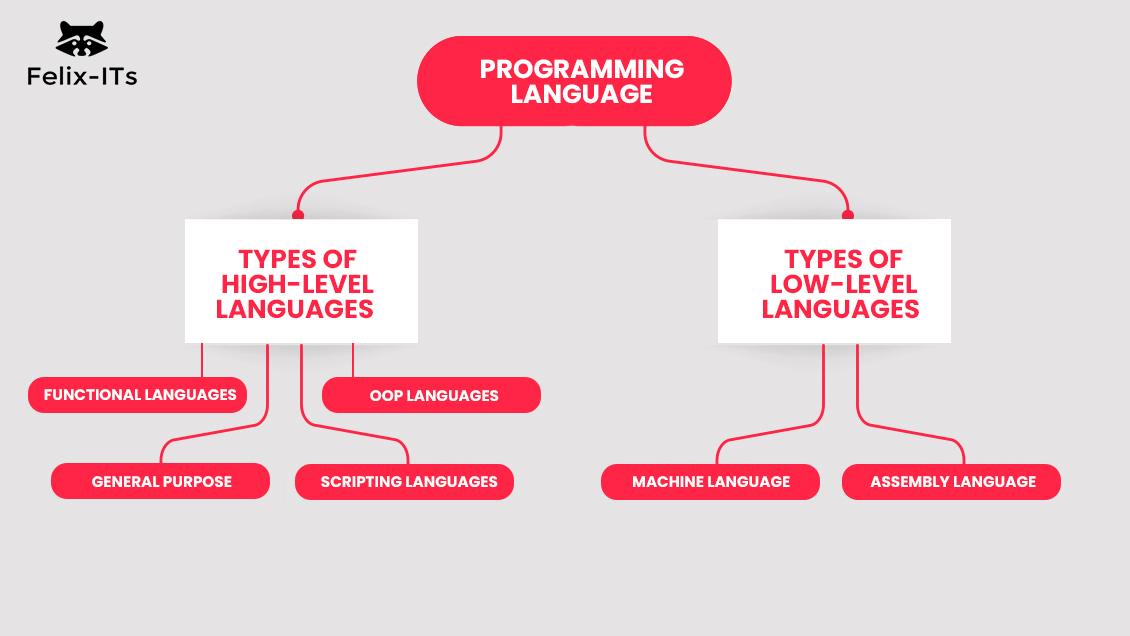Programming languages fall into two types: high-level and low-level. High-level languages resemble human languages such as English. Meanwhile, low-level ones closely resemble machine language, comprised of binary strings. Despite their distinctions, both types serve vital roles in computing. High-level languages are used for making applications, while low-level languages are best for firmware and embedded systems.
Felix-ITs is a leading institute offering the best IT courses that can cover both high-level and low-level programming languages.
In this article, we will cover the major differences between these languages along with their advantages and disadvantages!

What is High-Level Programming?
High-level programming is a type of coding language that is similar to human language. This language allows developers to better focus on problem-solving rather than the complex hardware operations. High-level programming is simpler than low-level languages. Focusing on specific program development, with easier comprehension and implementation of frameworks.
High-level programming languages, starting with Fortran in 1957, evolved to offer human-like syntax and increased productivity. From COBOL for business to Python for versatility, they’ve adapted to meet diverse programming needs.
So, let’s take a look at the key pros and cons of high-level programming languages!
Pros
Easier to learn and use: High-level languages allow you to write English instead of complex codes for easier use. It uses keywords like “if,” “else,” and “for,” making them more human-readable.
Faster development: Less time writing code means quicker project completion. Built-in functions and libraries offer pre-written code blocks for common tasks, saving time and effort.
Portability: You can write once and run almost anywhere. High-level languages work on different devices easily because they don’t rely on specific hardware details.
Maintenance friendly: Since the code is easier to understand, fixing bugs and making changes become simpler.
Cons
Slower execution: High-level languages need translation into machine code before the computer understands them. This extra processing can make high-level languages slower than low-level ones.
Less control: High-level languages hide the inner workings of the hardware. This can restrict a programmer’s ability to optimize the code for the best performance.
Resource usage: The translation process and additional features of high-level language can consume more resources. Resulting in increased RAM usage during code execution.
It is safe to say that high-level languages are great when it comes to ease of use and effective performance. They are perfect for applications where development speed and code maintainability are the priority. However, in cases where speed and hardware control are needed, high-level languages are simply not the best fit.
Types of High-Level Languages
Programming languages have evolved and there are a variety of options. Let’s take a look at some of the most popular types of high-level programming languages.
General purpose: These languages tackle a wide range of tasks. Popular examples include Python (known for its readability), Java (widely used in enterprise applications), and C++ (powerful for system programming).
Scripting languages: These languages are popular for web development and automation because they are easy to use and write compact code. Examples include JavaScript (essential for interactive web features) and PHP (commonly used for server-side scripting).
Object-oriented programming (OOP) languages: These languages use objects to represent real-world entities, combining both data and the actions that can be done with that data. Examples include C# (for making Windows apps) and Java (commonly used for Android apps).
Functional languages: Functional languages prioritize functions as the main components of programs. They usually concentrate on defining what the program should accomplish rather than the specific steps of how to achieve it. For instance, Haskell is commonly used in academic settings and for developing complex software. Meanwhile, Scala is popular for constructing large-scale data systems.
What is Low-Level Programming?
Low-level programming refers to coding that directly interacts with the computer’s hardware. It’s close to machine language and offers precise control over system resources. Low-level languages are used for tasks like managing memory and controlling devices. But they require a deep understanding of how computers work.
Pros
Fine-grained control: Low-level languages offer direct access to hardware, enabling precise manipulation of memory, registers, and instructions. This grants programmers the ability to squeeze out maximum performance, crucial for tasks like device drivers and graphics rendering.
Portability: They can be used to write code that is more portable across different platforms and architectures.
Learning: Provides a deeper understanding of computer architecture and how software interacts with hardware.
Performance: Low-level languages offer direct control over hardware, resulting in optimized performance.
Access to hardware features: Developers can directly interact with hardware components, enabling tasks such as device drivers or embedded systems programming.
Small footprint: Programs written in low-level languages tend to have smaller memory footprints compared to higher-level languages due to minimal runtime overhead.
Cons
Complexity: Low-level languages require a deep understanding of hardware architecture, making development more complex.
Error-prone: Manual memory management can lead to bugs such as memory leaks and segmentation faults.
Time-consuming: Writing code in low-level languages typically takes longer due to the need for meticulous attention to detail.
Less readable: Code written in low-level languages can be difficult to understand, maintain, and debug.
Scalability: Low-level languages may not be as suitable for large-scale projects where rapid development and scalability are prioritized.
Low-level languages give precise control and speed for tasks like system programming and device drivers. But they’re complex, slow to develop, and less portable. Choosing them means prioritizing performance and hardware control. For general tasks, high-level languages offer a better balance of efficiency and simplicity.
Types of Low-Level Languages
Low-level languages give precise control over hardware, prioritizing performance over simplicity. There are two main types: Machine Language and Assembly Language.
Machine Language:
- The rawest form, consisting entirely of binary instructions (0s and 1s) directly understood by the CPU.
- Highly specific to the underlying architecture (e.g., x86, ARM), making it incompatible between different processors.
- Example: Instructing the CPU to add two numbers would involve a specific binary code sequence unique to that processor.
Assembly Language:
- A step above machine code, offering human-readable instructions that correspond to machine code.
- Uses mnemonics (e.g., “MOV” for move, “ADD” for add) instead of binary digits.
- Still hardware-dependent, but provides a layer of abstraction, making it slightly more portable than machine language.
- Example: Assembly instruction “MOV EAX, [EBX]” translates to machine code that moves the data from the memory location pointed to by the EBX register into the EAX register.
Final Thoughts
The difference between high-level and low-level languages highlights the balance between abstraction and control in programming. High-level languages prioritize readability, ease of use, and portability. Making coding more efficient without diving into intricate machine-specific details. On the other hand, low-level languages provide precise control over hardware resources for optimal performance. But often increases complexity and reduces portability.
Learning either of these programming languages is beneficial for anyone looking to explore career opportunities in the IT industry. Felix-ITs offers some of the best courses to help students not only learn the fundamentals but also become proficient in them. After completion of the course, Felix-ITs also offers placement support to help students land their ideal careers across industries.
Get in contact with Felix-ITs and enroll in the desired course!


